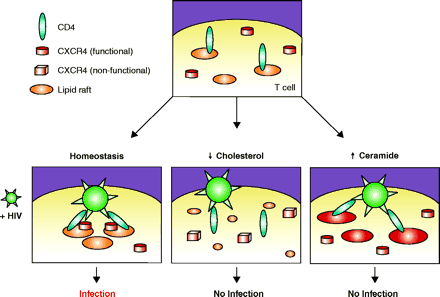
- Institution: Stanford Univ Med Ctr Lane Med Lib/Periodical Dept/Rm L109
- Sign In as Member / Individual
Targeting Lipids to Prevent HIV Infection

Model for targeting lipid rafts to inhibit HIV infection. On T cells, the HIV receptor CD4 is constitutively associated with lipid rafts at the cell surface, whereas chemokine receptors such as CXCR4 are normally excluded. Upon HIV binding and cell signaling, CXCR4 is recruited to rafts where they can interact with gp120, resulting in viral fusion to the cell membrane (bottom left). Treatment with BCD or statins to remove membrane cholesterol disrupts lipid rafts and cell signaling, resulting in an inhibition of HIV infection and a loss of chemokine receptor function (bottom center). Increasing membrane ceramide levels also alters the properties of lipid rafts (bottom right), possibly by displacing cholesterol from lipid rafts, which results in the inhibition of HIV infection. In contrast to treatment with BCD, increased ceramide in the cell membrane does not result in the loss of chemokine receptor function.


